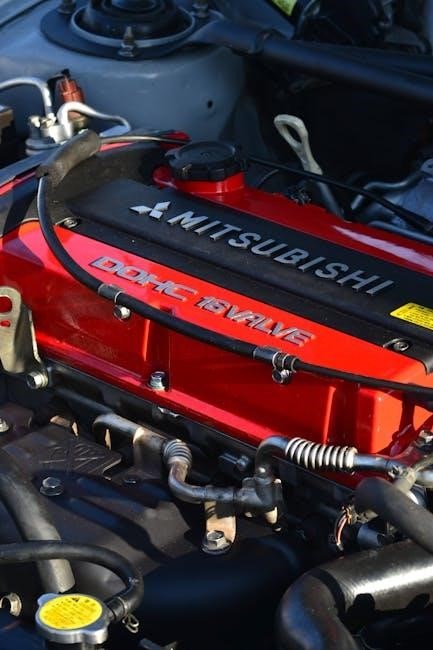Engine valve guides are cylindrical bushings in the cylinder head that guide the valve stem’s movement, ensuring proper alignment and preventing oil leakage. They play a crucial role in maintaining engine efficiency and preventing damage.
1.1 Definition and Purpose
Engine valve guides are cylindrical bushings located in the cylinder head, designed to guide the valve stem’s movement as it opens and closes. Their primary purpose is to ensure proper valve alignment, prevent oil leakage, and maintain efficient engine operation. By stabilizing the valve stem, they contribute to consistent engine performance and longevity. Valve guides are typically made from durable materials like bronze or steel to withstand high temperatures and wear. Their function is critical for maintaining combustion chamber integrity and overall engine efficiency.
1.2 Importance in Engine Operation
Engine valve guides are essential for maintaining proper engine operation by ensuring precise valve stem movement and alignment. They prevent oil leakage into the combustion chamber and minimize wear on moving parts. Misaligned or worn guides can lead to poor engine performance, increased oil consumption, and potential damage to valves and seats. Their role in stabilizing valve movement directly impacts engine efficiency, power output, and longevity. Durable materials like bronze or steel are often used to ensure reliability under high-temperature and high-stress conditions, making them a critical component for optimal engine functionality.
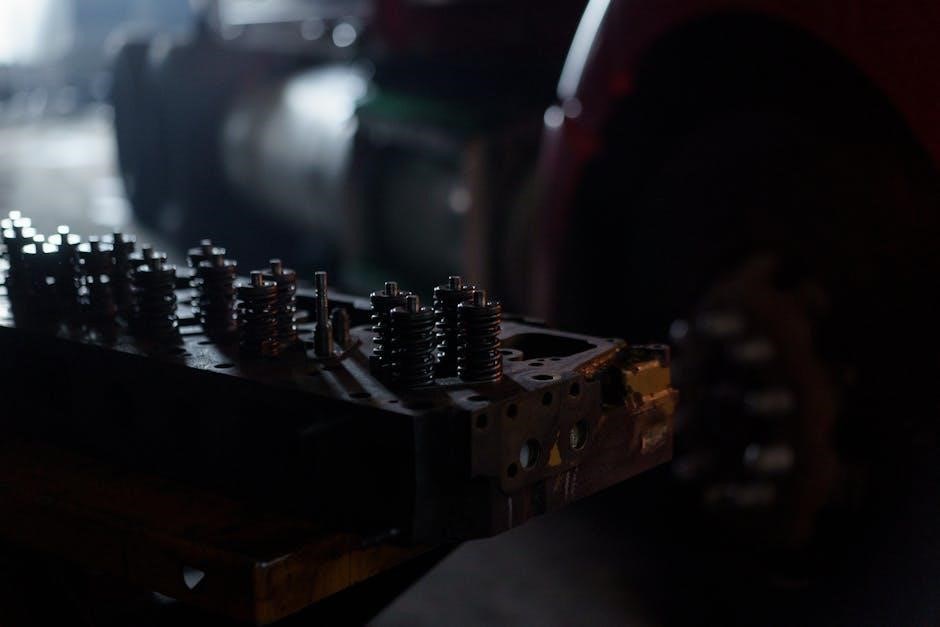
Components of Engine Valve Guides
Engine valve guides are typically cylindrical bushings made of durable materials like bronze, designed to fit within the cylinder head. They guide the valve stem precisely, ensuring smooth operation and preventing oil leakage into the combustion chamber.
2.1 Structure and Materials
Engine valve guides are cylindrical bushings typically made from durable materials like bronze or steel. These materials are chosen for their strength, heat resistance, and ability to minimize wear. The cylindrical structure ensures a precise fit within the cylinder head, guiding the valve stem smoothly. Some guides feature additional design elements, such as rings or coatings, to enhance performance and longevity. The choice of material and structure is critical to maintaining proper valve alignment and preventing oil leakage into the combustion chamber, ensuring optimal engine operation and efficiency over time.
2.2 Types of Valve Guides
Engine valve guides are available in various types, each designed for specific applications. Bronze valve guides are common due to their durability and heat resistance, often featuring rings to secure them in place. Steel guides are harder and more resistant to wear, making them suitable for high-performance engines. Some guides are coated or hardened for extra longevity. Additionally, certain engines may use cast iron or specialized materials for enhanced strength and thermal stability. Each type is chosen based on the engine’s requirements, ensuring optimal performance and minimal wear over time.
Functions of Engine Valve Guides
Engine valve guides are crucial for guiding the valve stem, ensuring proper alignment, and reducing wear. They prevent oil leakage and maintain combustion efficiency.
3.1 Guiding the Valve Stem
Engine valve guides play a critical role in guiding the valve stem’s precise movement, ensuring it operates smoothly within the cylinder head. By maintaining proper alignment, they prevent wobbling or misalignment, which could lead to premature wear or damage. The guides are designed to withstand high temperatures and stresses, ensuring reliable performance. Proper guidance is essential for efficient combustion and exhaust processes, directly impacting engine performance and longevity.
3.2 Ensuring Proper Valve Alignment
Engine valve guides are essential for ensuring proper valve alignment, allowing the valve stem to move accurately within the cylinder head. Misalignment can cause inefficient combustion, reduced performance, and potential engine damage. The guides are made from durable materials to withstand high temperatures and mechanical stresses, ensuring consistent and reliable engine operation over time, which is critical for maintaining optimal engine efficiency and longevity.
3.3 Reducing Wear and Tear
Engine valve guides play a critical role in reducing wear and tear by minimizing friction and preventing excessive movement of the valve stem. Made from durable materials like bronze, they withstand high engine temperatures and mechanical stresses. Properly functioning guides ensure the valve operates smoothly, reducing the risk of damage to the valve stem and surrounding components. Over time, worn guides can lead to oil leakage and reduced performance, emphasizing the importance of regular inspection and maintenance to maintain engine longevity and efficiency.
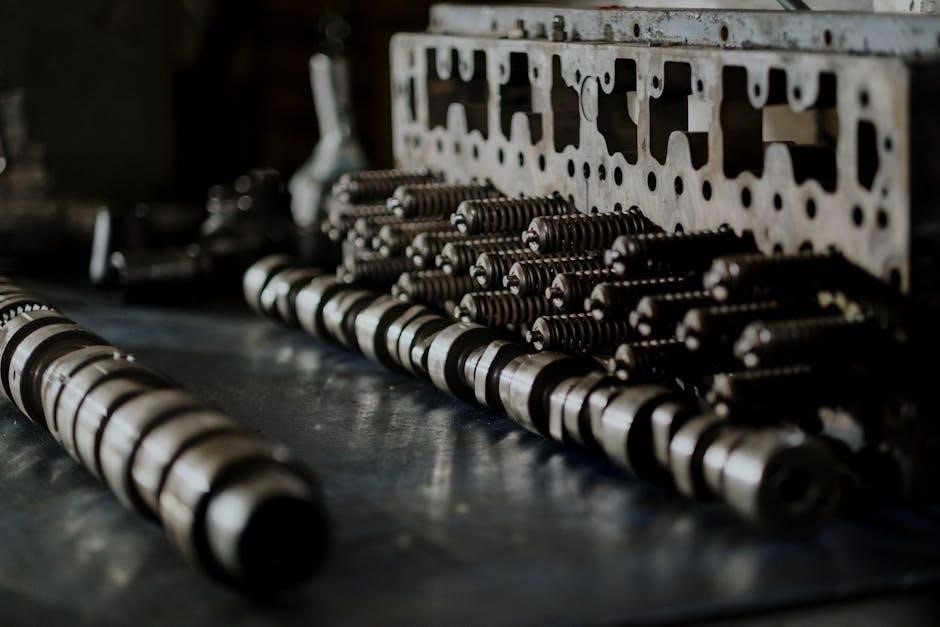
Installation and Replacement
Proper installation of engine valve guides requires precise alignment with the valve seat. Specialized tools, like presses or drills, ensure accurate fitting and prevent damage during replacement.
4.1 Proper Installation Techniques
Proper installation of engine valve guides involves precise alignment and fitting. Specialized tools, such as guide presses or drills, are used to ensure accurate placement. Measurement of the cylinder head is critical to achieve the correct clearance. The guide must be aligned with the valve seat to prevent misalignment. Torque specifications should be followed to secure the guide properly. Incorrect installation can lead to premature wear or engine damage. Using a dial indicator to check alignment ensures optimal fitment. Proper techniques guarantee smooth valve operation and long-term engine performance.
4.2 Tools and Measurements Required
Installing engine valve guides requires specialized tools, including a guide press, drill bits, and a dial indicator for precise alignment. Measurements are critical to ensure proper fitment. The inside and outside diameters of the guide must be checked for accuracy. The length of the guide is measured to ensure it fits the cylinder head correctly. A depth micrometer is used to verify the guide’s seating depth. Proper torque specifications must be followed when securing the guide. Using calibrated tools ensures accurate measurements, preventing installation errors and ensuring optimal performance.
Maintenance and Inspection
Regular inspection of engine valve guides is essential to identify wear and tear. Check for smoke emissions and improper alignment during maintenance to ensure optimal engine performance and longevity.
5.1 Signs of Worn Valve Guides
Common signs of worn valve guides include excessive smoke from the exhaust, particularly after starting the engine, and increased oil consumption. Noisy valve train operation, misfires, and decreased performance are also indicators. Over time, worn guides allow oil to seep into combustion chambers, leading to blue smoke. Proper inspection involves checking for movement in the valve stem and measuring guide clearance. Addressing these issues early prevents further damage to valves and engine components, ensuring smoother operation and efficiency.
5.2 Preventative Measures
Regular inspections and maintenance are key to preventing valve guide wear. Using high-quality materials and ensuring proper installation can extend their lifespan. Replacing worn guides promptly and aligning components precisely help avoid further damage. Routine checks for oil leakage and excessive smoke can identify issues early. Proper lubrication and avoiding overheating also contribute to longevity. Neglecting maintenance can lead to costly repairs, making proactive care essential for engine health and performance.
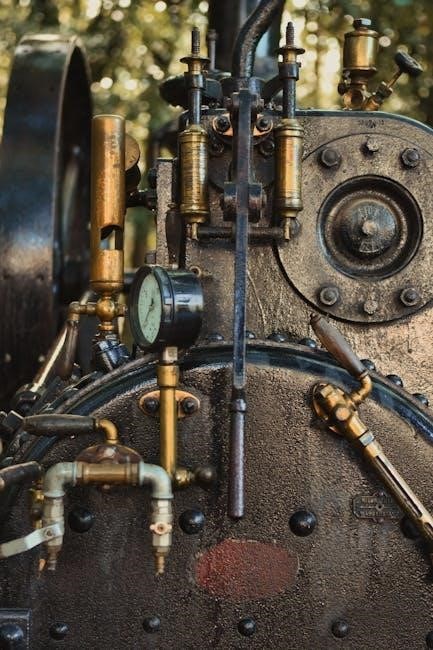
Common Issues and Repair
Common issues include excessive smoke due to oil leakage and worn guides. Repair involves replacing damaged guides, resizing valve stems, and ensuring proper alignment to restore functionality.
6.1 Symptoms of Damaged Valve Guides
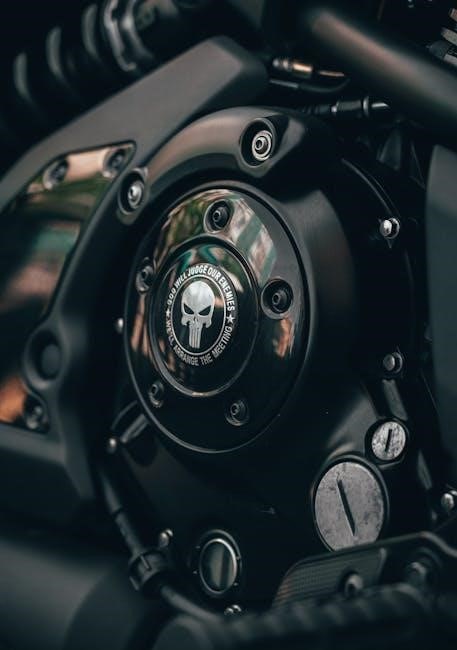
Common symptoms of damaged valve guides include excessive smoke from the exhaust, especially during startup, and increased oil consumption. Engines may experience rough idling, reduced power, and decreased efficiency. Worn guides can cause valve stems to misalign, leading to improper sealing and potential engine damage. In severe cases, this can result in blow-by gases escaping, further exacerbating the issue. Regular inspection is crucial to identify these signs early and prevent costly repairs.
6.2 Diagnosis and Repair Methods
Diagnosing damaged valve guides often involves visual inspection or using a camera to check for wear inside the manifold. Mechanics may perform a road test to observe smoke patterns. Repair typically involves replacing the worn guides, which requires precise tools and measurements. Proper alignment and seating are critical to ensure optimal performance. Preventative maintenance, such as regular inspections, can help avoid costly repairs. Replacing guides early prevents further damage to valves and engine components, ensuring long-term reliability and efficiency.
Performance Optimization
Upgrading to high-performance valve guides can enhance engine efficiency by reducing wear and improving heat dissipation, leading to better fuel efficiency and overall engine performance.
7.1 Impact on Engine Efficiency
Engine valve guides significantly influence engine efficiency by ensuring precise valve alignment and minimizing wear. Proper alignment enhances airflow and combustion efficiency, leading to better fuel economy. Reduced wear decreases the risk of oil leakage, preventing contamination of the combustion chamber and lowering emissions. Efficient valve operation also improves heat dissipation, preventing overheating and maintaining optimal engine performance. Overall, well-functioning valve guides contribute to a smoother-running, more efficient, and reliable engine.
7.2 Upgrading for Enhanced Performance
Upgrading engine valve guides can significantly enhance performance by improving durability and reducing wear. High-performance materials, such as bronze or coated guides, offer better heat dissipation and resistance to friction. These upgrades ensure tighter tolerances, reducing oil consumption and emissions. Additionally, upgraded guides can accommodate higher RPMs and increased cylinder pressure, making them ideal for modified or high-performance engines. Proper installation of performance-grade valve guides ensures consistent valve operation, leading to improved power output and engine longevity.
Engine valve guides are vital components ensuring efficient engine operation by guiding valve stems and maintaining proper alignment. They prevent wear, reduce oil consumption, and minimize emissions. Regular inspection and timely replacement are crucial to avoid damage. Upgrading to high-performance materials can enhance durability and engine efficiency. Proper maintenance of valve guides is essential for optimal engine performance and longevity, making them a cornerstone of reliable combustion engine functionality.
